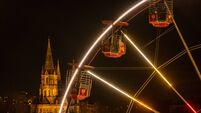Sky Matters: The Grand Stretch leads to Summer Solstice and a Supermoon in June

A setting for the Solstice…Dingle Druid, Juli Ní Mhaoileoin, joins A unique cultural celebration of the Summer Solstice at the iconic 6,000 year-old Killaclohane Portal Tomb near Milltown, Co. Kerry
As June approaches we can look forward to the continued lengthening of the days, at least until June 21 when we reach the Summer Solstice and the longest day of the year in the northern hemisphere.
The sun will then be at the highest point in the sky, directly over the Tropic of Cancer and roughly an altitude of 70 degrees above the horizon in Ireland. If the weather is clear, this is the most dangerous time for UV exposure as the amount of the earth’s atmosphere between us and sun is at its smallest.
It’s another reminder of the dangers of space exploration on bodies such as the moon, which has no discernible atmosphere and no UV protection, or Mars which has a very tenuous atmosphere and almost no protection. The only saving grace for Mars is that its distance from the sun means the amount of UV radiation reaching the planet is much less than on Earth. A kind of natural social distancing for radiation.
Prior to the solstice we have a partial solar eclipse on June 10. This is when the sun partly covers the face of the sun. On this occasion the moon will block out no more than 20% of the sun’s light as seen from Ireland. It’s really important that you don’t look at the sun directly during any of this eclipse. If you do want to take a look you’ll need solar eclipse glasses. You can use a projection method if you have a telescope, but never look at the sun at any time with a telescope, not even during an eclipse.
An interesting alternative possibility is to look at the dapples of sunlight cast through the leaves of trees. These are usually circular in nature, but during a partial solar eclipse they take on a crescent shape. Great fun for kids and lots of possibilities for artistic expression – you can even track how the crescent shape develops from the start of the eclipse at 9am to being most visible by eclipse maximum at 11am and back to circular at the conclusion of the eclipse at 1pm.
The moon may appear larger and brighter than usual, but the event won’t cause your head to spin or hair to grow uncontrollably on the back of your hand. One drawback of the long days is the short and relatively bright nights.
Even under the least light-polluted areas the sun’s light is reflected and scattered by particles high up in our atmosphere because at this time of the year it doesn’t set very far below the horizon. This is the same process that scatters light and causes our daytime sky to be blue. If we had super-sensitive eyes we could see that our night-time sky in June has a blue tinge too!
Yet another spacecraft reached Mars recently. China’s Tianwen-1 mission successfully deployed a lander and rover (called Zhurong) on the surface on May 14. On May 22, Zhurong made its first journey. It will look for signs of life, including any subsurface water or ice. This is a remarkable feat, but recent successes by the US and the UAE show that getting to Mars has become less problematic.
As we place more and more hardware on the Martian surface we increase the chance of seeding the planet with highly resistant bugs from Earth that have escaped spacecraft sterilization and interplanetary travel. To them, Mars might look rather welcoming. So we have reached a moment in our exploration of other worlds, and Mars in particular, when we may have to ask where did the Martians really come from?
- More information on what’s to see in the sky can be found at www.bco.ie/sky-matters/










